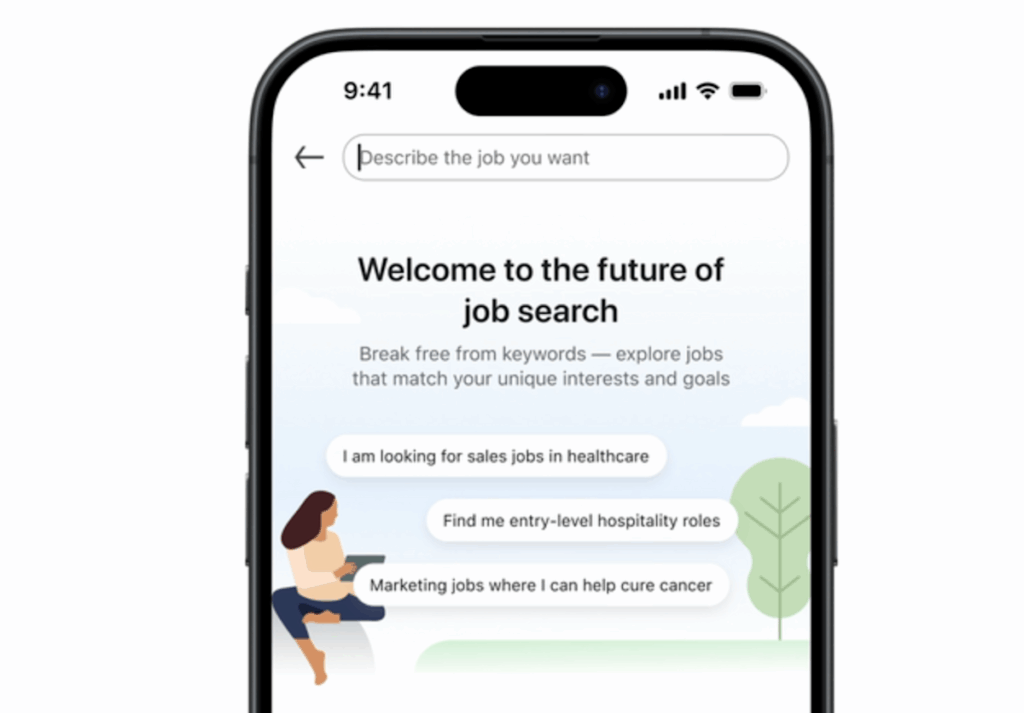
<span class=caption-credit> LinkedIn</span>
LinkedIn AI Job Search: How the New AI-Powered Features Transform Your Career Hunt
Table of Contents
- Introduction to LinkedIn’s AI Job Search Revolution
- Natural Language Search: Beyond Keywords
- Application Status Indicators: Real-Time Visibility
- AI Job Coaching: Premium Features for Career Advancement
- The Marketplace Reality: Job Seeker Growth vs. Available Positions
- Quality Over Quantity: LinkedIn’s Job Application Philosophy
- The Future of LinkedIn AI: Personalized Job Recommendations
- Implementation Tips: Making the Most of LinkedIn’s AI Tools
Introduction to LinkedIn’s AI Job Search Revolution
LinkedIn is revolutionizing its platform with a suite of AI-powered job search features designed to transform how professionals find their next career opportunity. The professional networking giant continues its mission to encourage more targeted job applications, but now with intelligent tools that make the process significantly more effective and personalized.
The new AI upgrades represent LinkedIn’s most substantial overhaul of its job search functionality in years, leveraging artificial intelligence to better understand both job seekers’ intentions and the nuanced requirements of posted positions. These innovations come at a critical time when job market competition remains fierce, and candidates need every advantage to stand out in a crowded applicant pool.
LinkedIn’s new AI-powered job search interface provides more intuitive search capabilities. Source: LinkedIn
Natural Language Search: Beyond Keywords
At the core of LinkedIn’s update is a complete revamp of its search functionality, moving away from rigid keyword matching toward a more intuitive natural language understanding system. This AI-powered search represents a paradigm shift in how job seekers can discover relevant opportunities on the platform.
Previously, LinkedIn’s job search relied heavily on specific keywords, requiring users to guess which terms might match the exact phrasing used in job postings. As LinkedIn product manager Rohan Rajiv explains, “Search used to be [a] very specific couple of boxes, and the box that really mattered was the box that said, ‘show me a title or a keyword or skill,’ and you basically had to hope that you will find a title or keyword or skill that the system understands.”
The new system allows users to express their career aspirations in natural, conversational language. Job seekers can now search using complex queries like “business development roles in the video game industry” rather than being limited to basic terms like “business development” or “video games.” This natural language processing capability enables the platform to understand the contextual meaning behind searches and deliver more relevant results.
LinkedIn AI Search Strategies
To maximize results with LinkedIn’s new natural language search:
- Be specific about industries, required skills, and work environments
- Include details about desired work arrangements (remote, hybrid, on-site)
- Mention career progression goals to find roles with growth potential
- Specify company size preferences (startup, mid-size, enterprise)
- Include geographic restrictions or preferences in your search query
Application Status Indicators: Real-Time Visibility
LinkedIn is adding valuable transparency to the job application process with new status indicators that show when companies are actively reviewing applications. This feature addresses one of the most frustrating aspects of job hunting: the uncertainty of whether applications are being considered or lost in a digital void.
When browsing job listings, users will now see clear indicators showing which positions have active hiring managers reviewing incoming applications. This real-time information helps job seekers focus their efforts on opportunities where they have a better chance of receiving consideration, rather than applying to dormant listings that may no longer be priorities for employers.

LinkedIn’s new interface showing when a hiring manager is actively reviewing applications. Source: LinkedIn
This feature represents LinkedIn’s acknowledgment that job seekers need better signals to navigate the often opaque hiring landscape, potentially reducing the frustration of sending applications into what feels like a black hole. The indicators serve both applicants and employers by encouraging more timely and relevant applications.
AI Job Coaching: Premium Features for Career Advancement
LinkedIn is enhancing its Premium subscription with AI-powered job coaching features that provide personalized guidance throughout the job search process. These tools leverage artificial intelligence to help users prepare for interviews, craft compelling pitches, and develop key professional skills.
The AI coaching functionality offers Premium subscribers the ability to practice interview questions specific to their target roles and industries. The system can generate realistic interview scenarios, analyze responses, and provide constructive feedback to help candidates refine their communication skills before facing actual hiring managers.
Additionally, the coaching feature helps users craft and practice elevator pitches and other professional presentations, ensuring they can articulate their value proposition effectively. This personalized guidance represents a significant advantage for job seekers willing to invest in Premium services, potentially giving them an edge in competitive hiring processes.
Making the Most of LinkedIn Premium AI Coaching
To maximize the benefits of LinkedIn’s AI coaching:
- Practice industry-specific technical interview questions
- Request feedback on your delivery style and communication clarity
- Use the AI to help tailor your responses to different company cultures
- Practice explaining employment gaps or career transitions
- Refine your salary negotiation techniques with AI guidance
The Marketplace Reality: Job Seeker Growth vs. Available Positions
While LinkedIn’s new AI tools offer powerful capabilities, they operate within the constraints of the broader job market reality. As Rohan Rajiv candidly acknowledges, “The reality is that we have a marketplace where the number of job seekers year-over-year is growing faster than the number of jobs year-over-year.”
This imbalance creates fundamental challenges that even the most sophisticated AI cannot entirely solve. LinkedIn’s approach is to help users navigate this competitive landscape more effectively rather than promising unrealistic outcomes. The company recognizes that technology alone cannot create more jobs, but it can help connect the right candidates with the right opportunities more efficiently.
The growing disparity between job seekers and available positions underscores why LinkedIn continues to emphasize quality over quantity in applications. As competition increases, standing out requires more targeted, thoughtful approaches rather than mass application strategies that were sometimes effective in less competitive eras.
Quality Over Quantity: LinkedIn’s Job Application Philosophy
LinkedIn has been consistently advocating for more selective job application strategies, a position that might seem counterintuitive to many job seekers. Rajiv reinforces this philosophy, stating unequivocally that “volume is not your friend in the job search.”
He elaborates on the systemic problems created by mass application approaches: “It’s only one extra apply, but you multiply that with 500 people, and suddenly the poster has got 500 new applicants that they are going to need to screen. That’s only making it worse.” This perspective highlights how individual actions collectively create market inefficiencies that ultimately harm both candidates and employers.
LinkedIn’s AI features are designed to support this quality-over-quantity approach by helping users find more relevant opportunities where they have better chances of success. The natural language search, status indicators, and coaching tools all serve to guide users toward more focused, strategic application behaviors rather than encouraging indiscriminate submission of resumes.
The Impact of Application Volume
| Approach | Impact on Job Seeker | Impact on Hiring Process |
|---|---|---|
| Mass Applications (50+ per week) | Lower quality applications, decreased personalization, application fatigue | Overwhelmed recruiters, automated rejections, longer processing times |
| Targeted Applications (5-10 per week) | Higher quality applications, proper research, tailored materials | More meaningful assessment, better candidate experience, faster decisions |
The Future of LinkedIn AI: Personalized Job Recommendations
LinkedIn’s current AI enhancements represent just the beginning of its vision for intelligent job matching. Rajiv offers a glimpse into future capabilities, suggesting that LinkedIn aims to provide even more proactive guidance: “You can imagine the possibilities of this: for us to say, ‘hey, this job probably [is] not a fit, but based on your skills, let me construct a search that will help you find what you are looking for.’ And I think that that is the future.”
This forward-looking approach points to a system that could not only understand what users are searching for but actively redirect them toward more suitable opportunities based on their unique skills, experience, and potential. Such capabilities would represent a significant shift from passive job boards toward truly intelligent career assistants.
The evolution toward more personalized, AI-driven job recommendations aligns with broader trends in the recruiting industry, where both candidates and employers increasingly value quality matches over high-volume hiring processes. LinkedIn’s massive professional dataset positions it uniquely to develop increasingly sophisticated matching algorithms that benefit the entire ecosystem.
Implementation Tips: Making the Most of LinkedIn’s AI Tools
To leverage LinkedIn’s new AI-powered features effectively, job seekers should adjust their strategies to align with the platform’s evolving capabilities. Here are practical ways to maximize these tools in your career search:
- Craft detailed search queries that include industry, role, skills, location preferences, and work arrangement expectations (remote, hybrid, on-site).
- Prioritize applications to positions with active status indicators showing hiring manager engagement.
- Develop a comprehensive LinkedIn profile that helps the AI understand your skills and experience for better search results and recommendations.
- If using Premium, regularly practice with the AI coaching tools to refine your interview skills and professional presentation.
- Focus on tailoring fewer, high-quality applications rather than submitting many generic ones.
- Combine AI tools with human networking – connect with professionals at target companies after identifying relevant positions through the AI search.
- Provide feedback on search results to help the system better understand your preferences and improve future recommendations.
LinkedIn AI Job Search: Key Takeaways
- LinkedIn’s new AI-powered search understands natural language queries beyond simple keywords
- Application status indicators show when companies are actively reviewing applications
- Premium subscribers gain access to AI coaching for interview preparation and pitch refinement
- Job seekers should focus on quality applications rather than quantity in the competitive market
- Future AI features will likely include more proactive job recommendations based on skills
LinkedIn’s AI-powered job search tools represent a significant advancement in how professionals can discover and pursue career opportunities. By embracing these intelligent features and aligning your approach with LinkedIn’s quality-over-quantity philosophy, you can navigate the challenging job market more effectively and potentially find your ideal next role with greater efficiency and less frustration.





